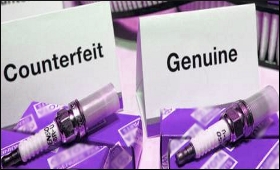|

|
Counterfeiting hitting India's brand image in export markets
|
|

|
|
| Top Stories |
 |
|
|
|
Anil Rajput | 09 Jul, 2012
Counterfeiting is being considered the world's fastest growing industry. According to current estimates, it represents up to 10 percent of global trade. Termed the crime of the 21st century by the FBI, fake and smuggled goods combine to make a $600 billion industry, which has grown by 10,000 percent in the past two decades, according to figures cited by The International Anti-Counterfeiting Coalition (IACC).
A recent study conducted by Business Action to Stop Counterfeiting and Piracy indicates the global value of counterfeit and pirated goods, currently estimated at US$600-650 billion, is likely to more than double by 2015. Along with smuggling, counterfeiting and fake have become major contributors towards generation of black money, which in turn encourages criminal activities including terrorism.
The market for fake and counterfeit products is thriving in India and has become one of the biggest challenges faced by Indian industry. Not only is it adversely impacting genuine stakeholders, industry, the government and consumers, it is also impacting "Brand India" globally. At the time when Indian industry is looking to broaden its base, it is challenged by "Made in India" syndrome - a big and growing international business where all kinds of sub-standard healthcare, beauty, FMCG and electronic parts are being pushed into the market.
With this background, industry body FICCI set up a Committee Against Smuggling and Counterfeit Activities Destroying the Economy (CASCADE). FICCI CASCADE has been set up with the participation of leading industries from all sectors of the economy.
Several steps are being taken by FICCI CASCADE and the government to create large-scale awareness among the most impacted segment of this menace: the consumer. A joint publicity campaign has been started in association with the Ministry of Consumer Affairs under the "Jago Grahak" umbrella to create awareness among consumers. Another proposed initiative is with the Delhi Government's "Bhagidari" campaign.
FICCI CASCADE recently sponsored the 5th Hum Kishore Festival in which more than 100 schools from Delhi and the NCR participated. June 13 was marked "Anti-Counterfeiting Day".
According to FICCI CASCADE, spurious goods are available in pharmaceutical drugs, FMCG, computer and software goods, soft drinks, cosmetics and toiletries and are rampant in the automobile sector. Estimates of fake medicines sold in India vary from 0.4-20 percent. Medicines purchased without invoice or bill may well be fakes. Instead of improving the health of the patient they may worsen the condition.
According to a study on the fake automotive spare parts, the market in India is estimated to be around Rs.2,500 crore, which is approximately 35 percent of the total auto parts sold in the country.
The White Paper on Legislative Improvements to Combat Counterfeit Auto Parts by ACMA strongly underlines the need for strong legislation to tackle the problem. Based on primary research, it is estimated that around 20 percent of total road accidents in India can be either directly or indirectly attributed to counterfeit automotive parts. Their use led to 25,400 deaths and more than 93,000 injuries in 2009. According to estimates, the end-users are paying for an additional 109 million litres of petrol and eight million litres of diesel per annum due to the use of counterfeit parts.
In IT, it is estimated that a mere 10 percent reduction in piracy rate has the potential to create 50,000 additional jobs in India. IT is possibly the worst affected with 80 percent of fake goods because of the huge potential of price differential.
Rapid advances in technology, liberalisation of the Indian economy and booming demand for brands have in a way facilitated the counterfeiters in making a fast buck at the cost of society. Members of the organised sector make heavy investment in research and technology to produce quality products to serve customers. These well meaning efforts are however threatened by spurious lookalikes and fakes at competitive prices.
This adversely impacts the health, safety and well-being of consumers as well as revenue of state and central governments. Counterfeiting is a serious crime and perpetrators have to be dealt with effectively.
|
|
|
| |
|
|
|
|
|
|
|
counterfeiting
Hans | Tue Jul 10 18:14:59 2012
With the vast amounts of money circulating in this circuit of counterfeiters and the traditional deeply rooted corruption in India we wonder whether an institution like FICCI Cascade can control it's inspectors/members of accepting bribes.

|
|
|
|
|
|
|
| |
| Customs Exchange Rates |
| Currency |
Import |
Export |
US Dollar
|
66.20
|
64.50 |
UK Pound
|
87.50
|
84.65 |
Euro
|
78.25
|
75.65 |
| Japanese
Yen |
58.85 |
56.85 |
| As on 13 Aug, 2022 |
|
|
| Daily Poll |
 |
 |
| PM Modi's recent US visit to redefine India-US bilateral relations |
|
|
|
|
|
| Commented Stories |
 |
|
|
|
|
|
| |
|